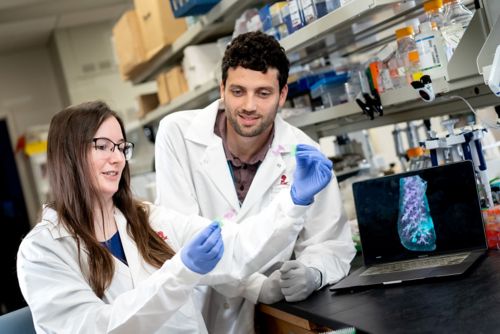St. Jude Family of Websites
Explore our cutting edge research, world-class patient care, career opportunities and more.
St. Jude Children's Research Hospital Home

- Fundraising
St. Jude Family of Websites
Explore our cutting edge research, world-class patient care, career opportunities and more.
St. Jude Children's Research Hospital Home

- Fundraising
Influenza and gene therapy researchers team up to create more effective flu vaccine

St. Jude Graduate School of Biomedical Sciences students Kristin Wiggins and Stephen Winston collaborated on a study to design a better flu vaccine.
Between 1918 and 1920, a devastating influenza (flu) pandemic claimed an estimated 25-50 million lives globally. It wasn’t until twenty years later that scientists developed a protective vaccine against the influenza virus. Despite the existence of an annual vaccine, seasonal flu continues to cause millions of illnesses and upwards of half a million deaths worldwide each year.
St. Jude is part of the international effort to develop new and improved flu vaccines to combat the breadth of circulating flu viruses and stave off another global pandemic. In a study published recently in the Journal of Virology, scientists unveiled a promising new approach to the flu vaccine. A single dose of the novel vaccine produced a broad long-lasting immune response in a pre-clinical model. In that model, the new vaccine outperformed currently available options.
Optimized antigen broadens flu vaccine’s protective effects
Co-corresponding authors Stacey Schultz-Cherry, PhD, Department of Host-Microbe Interactions and Andrew Davidoff, MD, Department of Surgery chair, credit St. Jude Graduate School of Biomedical Sciences students Kristin Wiggins and Stephen Winston with the project’s success.
Winston works on optimizing adeno-associated virus (AAV) vectors as a gene therapy delivery system in Davidoff’s lab. It was in a grant writing workshop that Winston and Wiggins, who works on novel flu vaccines in Schultz-Cherry’s lab, came up with the idea to partner up. “We thought the AAV vector would be a good candidate for a vaccine as we could get prolonged antigen expression from a single dose,” Winston said. “That would potentially enable the immune system to have ample opportunity to mount a response against influenza.”
The students aimed to improve upon a previous recombinant adeno-associated virus (rAAV) vector-based influenza vaccine by combining a flu-specific computationally optimized broadly reactive antibody (COBRA) with the rAAV platform.
COBRA allows scientists to design the ideal vaccine antigen from multiple sources using computational tools. They align the most conserved and immunogenic parts of a protein taken from different sources such as flu strains from different years and geographical locations. Once scientists identify conserved immunogenic sequences called epitopes, they can be stitched together to create a new antigen.
“By introducing the immune system to diverse epitopes, we can stimulate a broad breadth of antibody responses that can both neutralize and protect against infection and disease,” said Wiggins.
Traditional flu vaccines target the hemagglutinin (H1) protein, but scientists are limited to choosing a single H1 sequence from a single strain from a single year. Using COBRA, the research team made an H1 antigen with the most immunogenic epitopes from many H1-containing flu strains isolated over several years. The result was an improved broad anti-flu antibody response that protected mice from virus exposure. That included protection from H1-containing flu strains that were not used in the design of the antigen, something that the normal seasonal vaccine failed to do.
The rAAV-COBRA vaccine also protected ferrets with prior influenza exposure from illness after exposure to a new flu virus. “In contrast to mice, ferret lungs and immune responses better mimic what we see in humans,” explained Wiggins. The flu immune response in humans is shaped by prior flu vaccinations or infections. By overcoming this prior immune memory in the ferret model, the rAAV-COBRA vaccine shows it has potential to protect humans.
AAV vector drives effective flu vaccine response
The COBRA aspect of the vaccine provided unprecedented breadth against many flu strains, but it was the rAAV vector platform that likely provided the robust and long-lasting immune response.
AAV allows for long-term gene expression in target cells, which is why it is used in gene therapy. “It is very possible that AAV expresses the immunogenic protein for a long time,” Davidoff explained. “The body gets to see it and be exposed to it for weeks, as opposed to probably days when you just give dead virus.”
In addition to inducing long-term gene expression, AAV vectors are naturally immunogenic because they contain CpG motifs, short DNA molecules in their genomes that are recognized as foreign by the human body. While detrimental for gene therapy, that same trait is beneficial for a vaccine platform.
“Typically, we want to get rid of CpG motifs to make the vector less immunogenic,” said Davidoff, who builds AAV vectors to treat hemophilia. “We want to do the opposite when making a vaccine; we want even more CpG motifs.”
Normally, scientists add adjuvants, substances that enhance the immune response, to a vaccine. CpGs make that unnecessary, as they are self-adjuvanting and confer the benefit of modularity. “With this vaccine, we can manipulate the CpG amount, which we can’t do with a normal adjuvant,” said Schultz-Cherry. “You can dial it up or down depending on what you need. This modifiable property also makes the rAAV-COBRA vaccine customizable for different populations. For example, it may be that in the elderly you would need more of that adjuvant, but if you were using it in another population, you wouldn't want that.”
The researchers also showed that the AAV vaccine platform’s long-term antigen expression and CpG enrichment are potent activators of a robust helper T cell response. These important immune cells are crucial to a successful, long-lasting vaccine memory response.
Out-of-the-box approaches like the rAAV-COBRA vaccine may lead to better or even replace seasonal flu vaccines.
If you are interested in licensing compositions and methods for self-adjuvanting AAV vaccines (SJ-23-0004) for further development and/or commercial use, find out more about licensing.






